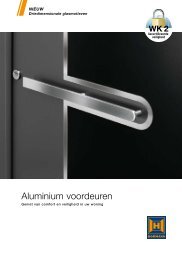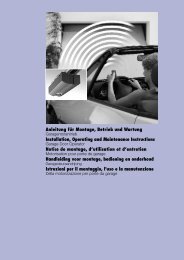2 - Hormann
2 - Hormann
2 - Hormann
Create successful ePaper yourself
Turn your PDF publications into a flip-book with our unique Google optimized e-Paper software.
DIL switch 6: function of the safety device when<br />
opening (see Figure 6.4 )<br />
The function of the safety device when opening is set<br />
with this switch.<br />
6 OFF Without function<br />
6 ON Stop the leaves<br />
4.4 Learning the gate's end-of-travel positions<br />
• The following DIL switches must be set:<br />
DIL switch 4: Set-up mode (see Figure 6 )<br />
4 ON Set-up mode ON<br />
DIL switch 3: Leaf selection/size of leaf offset<br />
(see Figure 6a/6b )<br />
3 OFF Leaf selection function:<br />
Single-leaf (A), double-leaf traffic leaf (A)<br />
We recommend using a mechanical limit stop in the<br />
CLOSE end-of-travel position, because<br />
- the leaf will lie firmly against the limit stop and cannot<br />
be moved by wind<br />
-leaves in double-leaf systems are aligned exactly flush<br />
with each other when in CLOSE end-of-travel position<br />
Note<br />
The safety devices are not active during set-up mode.<br />
Note<br />
In double-leaf systems with leaf offset, be sure to start the<br />
learning process with leaf A (traffic leaf).<br />
4.4.1 Recording the CLOSE end-of-travel position via<br />
the integrated limit switch (see Figure 6a.1 )<br />
56<br />
ENGLISH<br />
Note<br />
Before learning the end-of-travel positions, make sure that<br />
the integrated limit switch is activated. The BN/WH wires of<br />
the limit switch are clamped to plug 5/6 (see Figure 4.4a ).<br />
The options relay has the same function as the red LED<br />
during set-up. The limit switch setting can be viewed from<br />
afar via the connected lamp (lamp/LED off = limit switch<br />
reached – see Figure 4.7b ).<br />
• Uncouple the operator<br />
•Slowly close the gate by hand<br />
• The LED (or the lamp connected to the options relay)<br />
will go out when the limit switch is reached<br />
•Adjust the limit switch if necessary (see Figure 6a.1 )<br />
and move the gate accordingly until the desired CLOSE<br />
end-of-travel position is reached<br />
• Open the gate again halfway<br />
• Re-couple the operator<br />
Press circuit board button T and keep it pressed. The<br />
leaf will move to the limit switch and the red LED will go<br />
out. Now release the button.<br />
* Accessory, not part of the standard equipment!<br />
Note<br />
If the gate moves in the OPEN direction, check the motor<br />
connection and, if necessary, reconnect (see Figure 4.2/4.3 ).<br />
Then perform a factory reset (see Chapter 6) and repeat the<br />
procedure.<br />
Readjust if the position of the limit switch does not<br />
correspond to the desired position. For this purpose, the<br />
adjusting screw is adjusted with an Allen key (3 mm).<br />
At the same time carefully move the limit switch line in<br />
the appropriate direction to support it.<br />
Note<br />
Do not use a cordless screwdriver to adjust! One rotation<br />
of the adjusting screw equals 1 mm on the spindle.<br />
Correcting the end-of-travel positions:<br />
Increase end-of-travel position ➜ Turn adjusting screw<br />
towards "-" step-by-step<br />
Decrease end-of-travel position ➜ Turn adjusting screw<br />
towards "+" step-by-step<br />
Follow the set end-of-travel position until the red LED<br />
goes out using the impulse function in dead man<br />
operation and circuit board button T. Repeat this process<br />
until the required end-of-travel position has been reached.<br />
OPEN end-of-travel position<br />
Move the operator to the desired OPEN end-of-travel<br />
position using the impulse function in dead man operation<br />
and circuit board button T. Press button P to confirm<br />
this position. The green LED will signal that the end-oftravel<br />
position is detected by quickly flashing.<br />
Double-leaf gate system<br />
With a double-leaf gate system, DIL switch 3 must be<br />
ON (function: leaf selection) and the steps listed in<br />
Chapter 4.4.1 repeated for leaf B (see Figure 6a.2 ).<br />
4.4.2 Detecting the end-of-travel position via mechanical<br />
limit stops* (see Figure 6b.1 )<br />
Note<br />
It is essential that you deactivate the integrated limit switch<br />
before learning the end-of-travel positions via mechanical<br />
limit stops. Open the operator and remove the WH and BN<br />
wires from terminals 5 and 6. Insert a wire jumper (not in the<br />
scope of delivery) (see Figure 4.4b ). Then close the operator.<br />
CLOSE end-of-travel position<br />
Press circuit board button T and keep it pressed. Move<br />
the operator in the CLOSE direction until the control<br />
shuts itself off. Then release the button. The red LED<br />
will remain illuminated after the end-of-travel position<br />
has been detected.<br />
Note<br />
If the gate moves in the OPEN direction, check the motor<br />
connection and, if necessary, reconnect (see Figure 4.2/4.3 ).<br />
Then perform a factory reset (see Chapter 6) and repeat the<br />
procedure.<br />
➤<br />
08.2007 TR10A028-A RE












